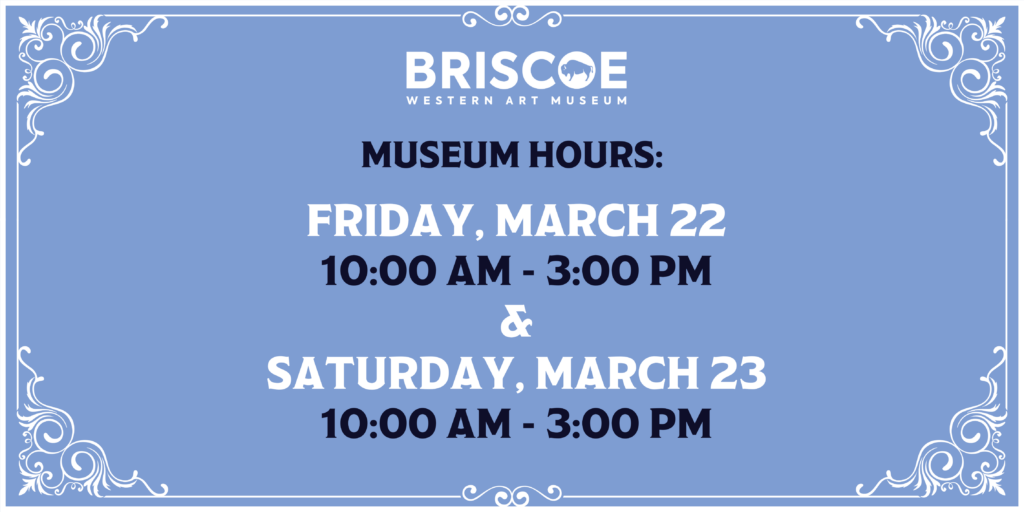Conflict in the A- Gallery
Of all the galleries in the Briscoe Western Art Museum, none are more frequently visited than the A- Gallery. The A- Gallery was named by the ‘Tex’ Elliott family in honor of their ranch home and their passion for Texas art and history. Also known as the “Conflict Gallery” this relatively small space in the museum attracts more school groups than any other as its displays combine art and historical artifacts to tell a broad story of nation-building in Texas. While these stories played out locally, they could have happened anywhere in the West.
Themes of courage in the face of adversity, the struggle for cultural supremacy, and the search for freedom in a boundless landscape are common themes in Western art and history. Before it ever became “The American West,” the whole landscape was an enormous question mark. No nation could completely say what would become of the territory, how many countries it would become and who would rule those countries. The sublime depictions of the landscape by artists and the possible riches they held prompted massive migration. This migration into the West led to countless stories of discord over land, beliefs, and nationality. The groups involved would change, but the fundamental essence remained the same, the West was (and in many ways continues to be) a region shaped by conflict. Thanks to depictions in Western art, film, and literature, one of the most enduring examples of this conflict is the Battle of the Alamo.
Upon entering the A- Gallery, The most striking work is the scale model of the Battle of the Alamo. The diorama features hundreds of figures all fabricated to reflect the historically accurate appearance of the Texian and Tejano people inside the Alamo as well as the various units of the Mexican army and the uniforms that indicated their position and ranks. The vast majority of school groups that come to the museum are local students in their social studies classes, covering a unit on Texas history. While many of these students have lived their whole lives in San Antonio and may have even been to the Alamo historic site, the expansion of the city over the years has drastically reduced the appearance of the old fortress. The diorama is hand-painted and painstakingly detailed, to recreate the battlefield, and convey to the students in a unique way, the sheer desperation of the outnumbered Alamo garrison, as well as dialogues from those involved in the conflict on both sides. Historical commentary is taken from David Crockett, William Travis, his African-American slave Joe, Suzanna Dickinson, José Enrique de la Peña, and President-General Santa Anna provide depth to the display and show the conflict play out in the lives of real people whose lives were forever impacted by the battle. The message that comes through as visitors move from one individual’s monologue to another is that there are always two perspectives to every conflict.
Surrounding the diorama are artifacts and artwork that reflect the series of struggles between Mexican, Texian and Comanche nations. Some of these pieces are authentic pieces of history, such as a Mexican cavalry uniform and a 9-pounder cannon used at the Alamo others are artistic representations of history that convey not only the look of the conflict in South Texas but the emotion involved in the prelude to the battle.
In a place of great prominence, to the left of the historic cannon, is a life-sized sculpture of William Barrett Travis, saber drawn, and a bronze “line in the sand” scratched near his feet. This story, as depicted by the sculptor James Nathan Muir, is one of the most enduring tales surrounding the Alamo; that the 26-year-old commander would voluntarily offer his men a choice to leave the fortress (and certain death), or to stand with him in a battle. All involved were aware that victory would come through their commitment to an independent Texas and taking a stand against a leader they considered oppressive. The artist manages to pass this emotion on to the viewer as they observe the grave determination reflected in Travis’ bronze face.
While this story is one of the best known in relation to the 1836 battle, and a bronze “line in the sand” sits in front of the Alamo church today, this anecdote was originally related more than forty years after the battle and was likely a fabrication. However, the wonder of the artwork in this gallery (and in Muir’s work particularly) is in the thought and emotion it provokes. Adults and children of all ages stare, transfixed at the face of the sculpture, perhaps wondering what they would do in a similar situation and on which side of the line they would stand. It is in these moments that artwork brings history to life.
This blog entry was written by our Curator of Collections, Ryan Badger. Ryan has been at the Briscoe for two years and his primary focus as Curator of Collections is bringing the stories of the Briscoe to life through the curation of the collection.
BECOME A MEMBER
Help us bring the spirit of the West alive by becoming a Briscoe Partner!
Click here to become a member!
SUPPORT THE MUSEUM
Governor Dolph Briscoe and his wife Janey envisioned a Museum that would preserve the stories and traditions of the American West.






